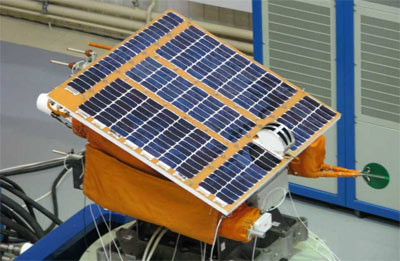Thank you very much for visiting Gunter's Space Page. I hope that this site is useful and informative for you.
If you appreciate the information provided on this site, please consider supporting my work by making a simple and secure donation via PayPal. Please help to run the website and keep everything free of charge. Thank you very much.
Universitetsky 2 (Tatyana 2, RS 38)

Universitetsky 2 (Tatyana 2)
The Universitetsky 2 (Tatyana 2) was a small technological satellite developed by the Moscow State University (MGU) and built by NPP VNIIEM.
The overall objective was the measurement of TLEs (Transient Luminous Events) in Earth's atmosphere. The goal was to observe simultaneously TLE and NUV (Near-Ultraviolet) emission profiles in high temporal resolution (ms) in a wide spectrum of 8 bands.
Universitetsky 2 was built for a 1 year lifetime. It carried following instruments:
- MTEL (MEMS Telescope for Extreme Lightning)
- NUV+R (Near-Ultraviolet and Red radiation) detector
- SFD (Scintillation Flux Detector)
- BCU (Block of Central University) payload
- ETP (Electron Temperature Probe)
- MRM (Magneto-Resistance Magnetometer)
Launched as a piggy-back-payload on a Soyuz-2-1b Fregat rocket, it reached successfully orbit on 17. September 2009.
The Universitetsky 2 spacecraft ended its operations on 16 January 2010 due to an attitude failure of the spacecraft. It has measured more than 1000 flashes during three months of its operation.
| Nation: | Russia |
|---|---|
| Type / Application: | Technology |
| Operator: | Moscow State University (MGU) |
| Contractors: | NPP VNIIEM |
| Equipment: | |
| Configuration: | |
| Propulsion: | |
| Power: | Solar cells, batteries |
| Lifetime: | 1 year (planned); 3 months (achieved) |
| Mass: | 98 kg |
| Orbit: | 814 km × 821 km, 98.80° |
| Satellite | COSPAR | Date | LS | Launch Vehicle | Remarks | |
|---|---|---|---|---|---|---|
| Universitetsky 2 (Tatyana 2, RS 38) | 2009-049D | 17.09.2009 | Ba LC-31/6 | Soyuz-2-1b Fregat | with Meteor-M 1, Sterkh 2, UGATUSAT, Sumbandila, BLITS, IRIS |
Further Universitetsky missions:
|
Further RS (Radio Sputnik) missions:
|
